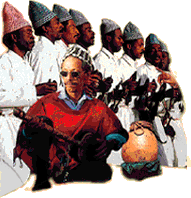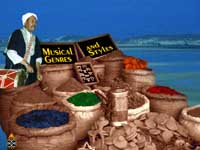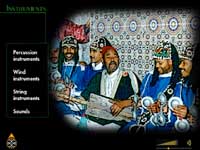

![]()



Morocco - Sounds from an Ancient Land is a monograph dedicated to the music, the tradition and to the culture of the Moroccan people. A voyage that, following the charmed paths of sound and rhythm, will allow the listener to unveil the most fascinating aspects of this ancient land and historical meeting point between East and West. The book comes with a CD-ROM and an audio CD in which one finds some of the finest pieces of all Moroccan music.
The CD-ROM, which contains about 100 photographs, 10 minutes of digital video, 30 pages of text and 50 minutes of sound tracks, is broken down into four main sections:
The Introduction to traditional Music of Morocco , with the use of hypertext, helps us to explore the origins and peculiarities of this nation's musical tradition. The link between the migratory phenomena and the characteristics of Arabic-Andaluse music as well as Berberian music– the two traditions that gave forth modern music-– becomes evident. The most widespread musical forms are highlighted (such as the nuba, melhun, gharnati), as well as the most common subject matter chosen for lyrics and the more popular instruments.
The largest section is obviously that dedicated to Music. Given the wealth of topics in this area,
this chapter is, in turn, subdivided into various sections. The part dedicated to Musical genres and styles
is sort of a interactive listener's guide to the musical pieces contained in the audio CD. Moroccan musical tradition
is closely examined, thoroughly uncovering all of the following aspects: the accomplished or finished tradition,
popular tradition and rural tradition, Sufis, folk songs and sacred music. For each of these genres, one can listen
to various excerpts from musical pieces.
A chapter is entirely dedicated to the Music of the Bedouins. Detailed hypertext explains the differences
between the songs, genres and instruments used by the Arabic Bedouins and the Amazigh Bedouins. Another chapter
discusses the role of the Saharan woman in the country's musical tradition; here one will discover details on the
female dance Guedra and learn about typical musical instruments from the Sahara regions.
Also very detailed and thorough is the section on Musical instruments. Hypertext with images and the relative
sound emitted by each instrument placed next to an interactive map allows one to play with the sounds of such instruments
as the qaraqèb, bendir, tarr, rèbab, 'ud, tbila, tbel, zamr, qanum, ghàita and many others.
The last chapter talks about Modern music in Morocco. Here one traces the evolution of Moroccan music and
its blending with other musical traditions over time. Many of the more famous protagonists of contemporary Moroccan
sound are "introduced", such as Jil Jilala, Nass El Ghiwane, Lem Chaheb.
In the chapter on Trance, discover all of the intrinsic mysteries surrounding altered states of consciousness and the role music plays in this. Also of interest are the rhythmic repetitions that accompany Sufi prayers and that characterise the fraternal orders of Gnawa and Jilala.
The Calendar explains which feasts and events mark the Islamic year; particularly interesting are the liturgical feasts like: Achùra, Ramadàn and Milùd, as well as the festival and moussem that are held throughout Morocco.
A co-production by Si.Lab and Planète Interactive with the sponsorship of the Ministry of Culture in Morocco.
Hardware requirements:
Windows 3.11 or Windows '95 with at least 8 MByte of RAM memory, CD-ROM drive double speed and an audio bit, at
least 256 high colour.
Click here to order Morocco. Sounds from an Ancient Land